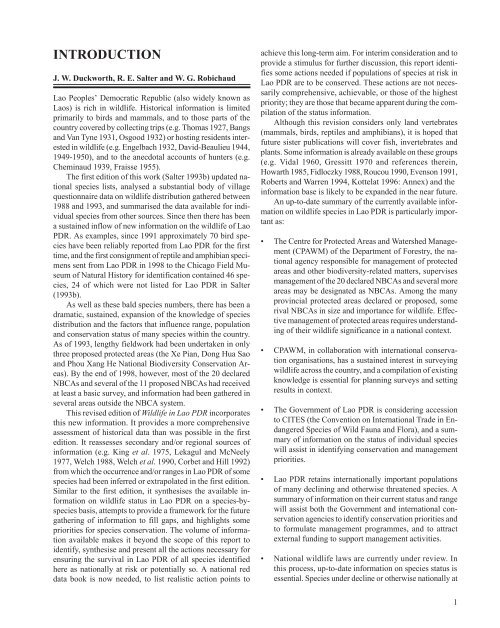Wildlife of Lao PDR: 1999 Status Report - IUCN
Wildlife of Lao PDR: 1999 Status Report - IUCN
Wildlife of Lao PDR: 1999 Status Report - IUCN
Create successful ePaper yourself
Turn your PDF publications into a flip-book with our unique Google optimized e-Paper software.
INTRODUCTION<br />
J. W. Duckworth, R. E. Salter and W. G. Robichaud<br />
<strong>Lao</strong> Peoples’ Democratic Republic (also widely known as<br />
<strong>Lao</strong>s) is rich in wildlife. Historical information is limited<br />
primarily to birds and mammals, and to those parts <strong>of</strong> the<br />
country covered by collecting trips (e.g. Thomas 1927, Bangs<br />
and Van Tyne 1931, Osgood 1932) or hosting residents interested<br />
in wildlife (e.g. Engelbach 1932, David-Beaulieu 1944,<br />
1949-1950), and to the anecdotal accounts <strong>of</strong> hunters (e.g.<br />
Cheminaud 1939, Fraisse 1955).<br />
The first edition <strong>of</strong> this work (Salter 1993b) updated national<br />
species lists, analysed a substantial body <strong>of</strong> village<br />
questionnaire data on wildlife distribution gathered between<br />
1988 and 1993, and summarised the data available for individual<br />
species from other sources. Since then there has been<br />
a sustained inflow <strong>of</strong> new information on the wildlife <strong>of</strong> <strong>Lao</strong><br />
<strong>PDR</strong>. As examples, since 1991 approximately 70 bird species<br />
have been reliably reported from <strong>Lao</strong> <strong>PDR</strong> for the first<br />
time, and the first consignment <strong>of</strong> reptile and amphibian specimens<br />
sent from <strong>Lao</strong> <strong>PDR</strong> in 1998 to the Chicago Field Museum<br />
<strong>of</strong> Natural History for identification contained 46 species,<br />
24 <strong>of</strong> which were not listed for <strong>Lao</strong> <strong>PDR</strong> in Salter<br />
(1993b).<br />
As well as these bald species numbers, there has been a<br />
dramatic, sustained, expansion <strong>of</strong> the knowledge <strong>of</strong> species<br />
distribution and the factors that influence range, population<br />
and conservation status <strong>of</strong> many species within the country.<br />
As <strong>of</strong> 1993, lengthy fieldwork had been undertaken in only<br />
three proposed protected areas (the Xe Pian, Dong Hua Sao<br />
and Phou Xang He National Biodiversity Conservation Areas).<br />
By the end <strong>of</strong> 1998, however, most <strong>of</strong> the 20 declared<br />
NBCAs and several <strong>of</strong> the 11 proposed NBCAs had received<br />
at least a basic survey, and information had been gathered in<br />
several areas outside the NBCA system.<br />
This revised edition <strong>of</strong> <strong>Wildlife</strong> in <strong>Lao</strong> <strong>PDR</strong> incorporates<br />
this new information. It provides a more comprehensive<br />
assessment <strong>of</strong> historical data than was possible in the first<br />
edition. It reassesses secondary and/or regional sources <strong>of</strong><br />
information (e.g. King et al. 1975, Lekagul and McNeely<br />
1977, Welch 1988, Welch et al. 1990, Corbet and Hill 1992)<br />
from which the occurrence and/or ranges in <strong>Lao</strong> <strong>PDR</strong> <strong>of</strong> some<br />
species had been inferred or extrapolated in the first edition.<br />
Similar to the first edition, it synthesises the available information<br />
on wildlife status in <strong>Lao</strong> <strong>PDR</strong> on a species-byspecies<br />
basis, attempts to provide a framework for the future<br />
gathering <strong>of</strong> information to fill gaps, and highlights some<br />
priorities for species conservation. The volume <strong>of</strong> information<br />
available makes it beyond the scope <strong>of</strong> this report to<br />
identify, synthesise and present all the actions necessary for<br />
ensuring the survival in <strong>Lao</strong> <strong>PDR</strong> <strong>of</strong> all species identified<br />
here as nationally at risk or potentially so. A national red<br />
data book is now needed, to list realistic action points to<br />
achieve this long-term aim. For interim consideration and to<br />
provide a stimulus for further discussion, this report identifies<br />
some actions needed if populations <strong>of</strong> species at risk in<br />
<strong>Lao</strong> <strong>PDR</strong> are to be conserved. These actions are not necessarily<br />
comprehensive, achievable, or those <strong>of</strong> the highest<br />
priority; they are those that became apparent during the compilation<br />
<strong>of</strong> the status information.<br />
Although this revision considers only land vertebrates<br />
(mammals, birds, reptiles and amphibians), it is hoped that<br />
future sister publications will cover fish, invertebrates and<br />
plants. Some information is already available on these groups<br />
(e.g. Vidal 1960, Gressitt 1970 and references therein,<br />
Howarth 1985, Fidloczky 1988, Roucou 1990, Evenson 1991,<br />
Roberts and Warren 1994, Kottelat 1996: Annex) and the<br />
information base is likely to be expanded in the near future.<br />
An up-to-date summary <strong>of</strong> the currently available information<br />
on wildlife species in <strong>Lao</strong> <strong>PDR</strong> is particularly important<br />
as:<br />
• The Centre for Protected Areas and Watershed Management<br />
(CPAWM) <strong>of</strong> the Department <strong>of</strong> Forestry, the national<br />
agency responsible for management <strong>of</strong> protected<br />
areas and other biodiversity-related matters, supervises<br />
management <strong>of</strong> the 20 declared NBCAs and several more<br />
areas may be designated as NBCAs. Among the many<br />
provincial protected areas declared or proposed, some<br />
rival NBCAs in size and importance for wildlife. Effective<br />
management <strong>of</strong> protected areas requires understanding<br />
<strong>of</strong> their wildlife significance in a national context.<br />
• CPAWM, in collaboration with international conservation<br />
organisations, has a sustained interest in surveying<br />
wildlife across the country, and a compilation <strong>of</strong> existing<br />
knowledge is essential for planning surveys and setting<br />
results in context.<br />
• The Government <strong>of</strong> <strong>Lao</strong> <strong>PDR</strong> is considering accession<br />
to CITES (the Convention on International Trade in Endangered<br />
Species <strong>of</strong> Wild Fauna and Flora), and a summary<br />
<strong>of</strong> information on the status <strong>of</strong> individual species<br />
will assist in identifying conservation and management<br />
priorities.<br />
• <strong>Lao</strong> <strong>PDR</strong> retains internationally important populations<br />
<strong>of</strong> many declining and otherwise threatened species. A<br />
summary <strong>of</strong> information on their current status and range<br />
will assist both the Government and international conservation<br />
agencies to identify conservation priorities and<br />
to formulate management programmes, and to attract<br />
external funding to support management activities.<br />
• National wildlife laws are currently under review. In<br />
this process, up-to-date information on species status is<br />
essential. Species under decline or otherwise nationally at<br />
1

















